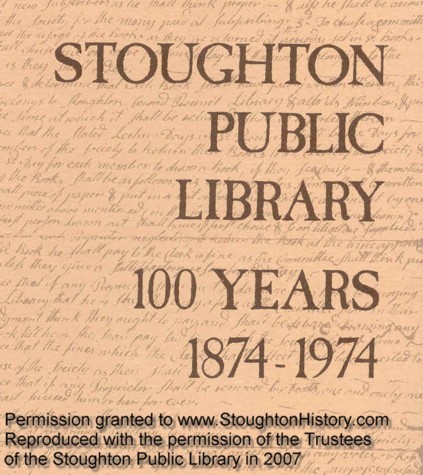
STOUGHTON PUBLIC LIBRARY
100 Years 1874 - 1974

The Trustees of the Stoughton Public Library gratefully acknowledge the generous assistance of the many interested citizens in the town encountered in searching out interesting facts and anecdotes from the historical background of our community and in verifying data for the Public Library's 10Oth Anniversary celebration. The Stoughton Historical Society was particularly helpful in supplying old documents and the nostalgic photographs which they permitted us to reproduce. Special appreciation is due to Edward Meserve for patient hours spent in the files of the Historical Society and to Bertha Reynolds, distinguished cataloguer of the Historical Society, who entertained us with personal recollections along with undisputed facts. John Flynn's Study in Local History provided many background details nowhere else obtainable; it is gratifying to note that Mr. Flynn was for many years a Trustee of the Public Library as well as an esteemed member of the Historical Society.
Mr. Robert Baum kindly allowed us access to his research notes on the Town in the 1870's, supplying a rich background of source material on the economic and social heritage of the times. Mr. Leonard Pinaud was of great professional assistance in compiling this brochure, adding many valuable suggestions for its future usefulness in the community. To the Library staff, the individuals in the town who volunteered their assistance, and especially to the devoted efforts of Librarian Anne Petterson, we express our gratitude.
The Trustees of the Stoughton Public Library
Francis M. Daly, Chairman
Helen Hansen, Secretary
Barbara Canavan
James L. O'Donnell
Arthur Stolow
Dorothy Woodward
Front Cover: the outside front cover is a reproduction of the original Covenant establishing a privately owned library, dated March 14, 1768. The inside front cover lists the signers of the original Covenant in 1768.
Centerfold: the centerfold is a reproduction of an 1876 map of Stoughton.
Back Cover: the outside back cover is a reproduction of the report of the Library Committee of the second precinct library on November 11,1789.
The inside back cover reproduces the inventory of books in the second precinct library on November 11,1789.
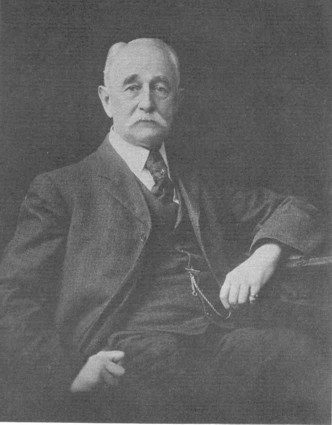
Wales French
Founder of the Stoughton Public Library
Librarian and Trustee
I. EARLY BACKGROUND OF THE TOWN OF STOUGHTON AND ITS LIBRARY.
According to local historian John Flynn, the first house was built in what is now Stoughton in 1716 by Deacon Isaac Stearns. By 1727, 121 houses had grown in this farming community, mainly along or near West St., which was close by the ancient Indian Way known as the Old Bay Rd. In the first survey recorded for the tax list in Stoughton in 1727, there were listed "7 saw mills, 2 grist mills, 4 iron works, 121 houses, 275 persons taxable, 763 cattle and horses; occupations: farmers, carpenters, lumbermen, cobblers & weavers. No books or periodicals, except the Bible, an almanac, Watts Hymns, and a catechism." Such names as Hewins, Talbot, Crane, Hubbard, Glover, and Dunbar were finding their way to the town.
While Samuel Adams was busy circulating letters denouncing the Townshend Acts to the other colonies in 1768, and British troops were arriving in Boston to protect customs officials, the little town of Stoughton was thinking about a library. Fifty-seven citizens signed a Covenant to establish the Stoughton Second Precinct Library, which held a yearly meeting for "signing the Corporating Covenant" and paying 6 shillings "as the conditions of admittance, stating none be allowed the Priviledges of the Library till conditions be fulfilled." The members bought the books, each charged equally; on stated days, they met and drew lots for the order of preference in withdrawing books. Membership was evidently highly prized, since only one heir was permitted to inherit it! Names now familiar in Stoughton were among the signers of the Covenant: Atherton, Morton, French, Sumner, Drake, Capen, Talbot, Bird, Gay, Southworth, Clap, Nathaniel Wales, Tolman, Monk, Swan, Page. Interestingly, in this same year, the first school building was erected on a piece of land which was one day to become the site of the elegant "new" library, now known as the Lucius Clapp Memorial Building.
In 1774, this busy community was chosen by Samuel Adams and Dr. Joseph Warren as the site of the County Congress which drew up the Suffolk Resolves, earning the local claim as the Cradle of Liberty in America. Still a thriving farming village, Stoughton sent 148 Minute Men to join the march along the Old Bay Rd., a major path to the Battle of Lexington. Altogether, 596 Stoughton men served in the Revolution; it was a major source of powder for the war; and Paul Revere cast cannons in its confines. Roger Sherman, only signer of the 3 major documents of American Independence, spent his childhood here; General Richard Gridley, first engineer of the U.S. Army, died at Stoughton Manor.
But despite the Revolution, the Covenant Library flourished in Stoughton, doggedly counting its books and establishing rules for its members. 1789 saw the first Presidential election in the United States, with Washington's Inauguration in New York that April, and the work of finishing the Constitution in full swing. In November of that year, an inventory of "books that were in the library" was taken by the Library Committee of Saul Shepard, Samuel Talbott, John Atherton, and John Holmes. Many were found to be "very durty and in a shattered condition." Fines of 4 pence were suggested for every 6 weeks a book was not returned.
The first "manufactory" was a straw hat shop at the "West Shares" in 1812; the Littlefield Brothers established the first shoe factory in 1815. However, these early industries were all handcrafted; often, work was farmed out to tiny shops in people's homes. When the railroad came to Stoughton in 1845, it created an economic surge in the small town which increased the industries and population considerably, changing its general character slowly from a farming to a manufacturing mill town. By 1 861, the population was nearly 5,000; prosperous boot and shoe manufacturers conducted a lively trade with Southern merchants, entertaining their buyers in large and somewhat luxurious houses, such as the Monk home on Pleasant St.
The advent of the Civil War, of course, put an end to this phase of Stoughton's prosperity, with many of its small factories going out of business. Even the local newspaper, edited by one William Wood, could not survive in the postwar apathy. Closing his doors for good, Mr. Wood rather bitterly announced that "the literary taste of the community needed development and cultivation." There followed no newspaper for 6 years!
During the postwar years, however, the invention of industrial machinery brought a rebirth of the shoe industry in Stoughton. The Wales, Littlefields, Porters, Fitzpatricks, and Frenches once more became leaders in the new industrial community. "Modern" factories employed hundreds of skilled and unskilled laborers, both men and women. The center of the town developed its own "tough little section", harboring not a few swindlers and petty thieves who found easy entry and egress in the thriving railroad center.
By the 1870's, many familiar Stoughton names and businesses had become established. Belcher & Bird had their boot factory; P. O'Brien made heels; H. M. Tucker built a carpet stretcher factory; Bradford May, a harness shop; James Taber, a paper box factory; French & Ward expanded their woolen mills; and the new Stoughton Boot & Shoe Co. had steam power in its brick building, employing 100 people. Laborers began to look for shorter hours in their long working day (12 hours); manufacturers began to fear the lengthening shadows of labor unions.
II. THE WORLD IN 1874.
Europe, in the 1870's, saw a tremendous growth in technical and scientific advances which found their way to this country in a short time. In 1871, Darwin publishes his Descent of Man, which was to influence the thinking of man for generations, causing a moral upheaval in Calvinistic America. Louis Pasteur and Robert Koch were laying the foundations for their discoveries on diseases in the 1880's. The "moving picture principle", using a series of cameras, was developed in 1872; combined with the magic lantern types, this process grew into our modern cinema industry. Bell and Edison would soon improve our standard of living with the telephone and phonograph.
Politically, Europe was still in the belligerent mood which had affected our Civil War. In Germany, Bismarck was engaged in his titanic struggle with the Church; at the same time, he was building Germany's military strength by alliances with Austria, Russia, and Italy. Of greater importance to observers here, however, was the establishment of a "state socialism", providing sickness and accident insurance and pension plans for workers. In the British Isles, Disraeli came to power for the second time in 1 874; the following year, he established a Public Health Law and housing for the poor. France was recovering once more from a German invasion of Paris, finally adopting a Republican Constitution in 1875.
One result noticed in the United States was a change in immigration from a predominantly English, Scotch and Irish stock. In 1874, over 300,000 immigrants arrived here, of whom the large majority were Austrians, Germans, Italians, and British. Machinery had lessened the hours spent in the fields; persecution also sped many to freedom.
Ulysses S. Grant was elected to his second term as President in 1872, in spite of the Credit Mobilier scandal, which touched his Vice President as well as the popular Oakes Ames of Easton. (In Stoughton, the campaigners were more interested in debating Ames' virtues than the politics of President Grant.) Subsequently, the Panic of 1873 followed the failure of the powerful banking house of Jay Cooke, leading to a severe decline in the economy and substantial unemployment.
The concentration of economic power in large Business Pools and Trusts, the founding of such huge companies as Rockefeller's Standard Oil and Bethlehem Steel, all placed emphasis in business on stockholders, not workers. Between 1864-73, the National Trade Union Movement was strong enough to cause concern among the small manufacturers such as Stoughton's. Many skilled shoe workers were displaced by "green hands", leading to the organization of the Knights of St. Crispin (1867) even in Stoughton, to protect its members against unskilled laborers. But the shoe workers' union was already declining by 1873; the Knights dissolved in '78. Even national unions dropped in membership in the "depression" from 1873-78.
Along with technical, scientific, and economic
progress, it was natural to find improvements in the printed page. Printing kept
pace with progress; by 1875, a rotary press gave the industry printing on both
sides of the page, cutting and folding in one process. The 1800's began the rise
of tax-supported local libraries; in 1851, Massachusetts passed a law permitting
towns to tax inhabitants for the support of free libraries. By the 1870's, best
sellers in American literature included Bret Harte's Luck of Roaring Camp,
Louisa May Alcott's Little Men, Eggleston's Hoosier Schoolmaster, Edward
Payson Roe's Barriers Burned Away, Mark Twain's Tom Sawyer, and
John Habberton's Helen's Babies. In 1876, the American Library
Association held its first Convention, establishing its distinguished Library
Journal.
First Stoughton Public Library
Morton Square
1874
III. STOUGHTON IN 1874.
The early 1870's were a rather turbulent era, with the rise of industrialism in the small towns, scandals in Washington, and the imminent Panic of '73 with its subsequent Depression, which would last about 5 years. At the same time these effects were felt in Stoughton, the town experienced the Temperance Movement and some reflections of Woman's Suffrage. Although the two latter often went hand in hand, it has been reported that Woman's Suffrage was not a popular issue here where women in politics were frowned upon, except as members of the School Committee.
The community of Stoughton retained much of its rural nature in the 70's; there were no gas or electric facilities available until 1 889, no telephone service until 1 896. The horse had not yet been replaced as the principal means of local transportation; the bicycle was still a popular vehicle for the gentlemen, even though it was slightly hazardous on the high-wheelers in vogue (the low-wheeled safety bicycle was not invented until 1885). Stoughton's early trade had been greatly increased when the railroad developed a terminal here in 1 845. But it was not until the transcontinental railroad was completed in 1870, making it possible to cross the country in seven days instead of a month, that the shoe industry in the town grew to its ultimate success. In 1870, the average per capita income in the United States was $779.00, over half the population were still living on farms, and many Americans never left the towns where they were born. This was quite a true picture of Stoughton, also.
However, the leaders of this town were apparently the owners and managers of the industries already flourishing. The names of Belcher, Wales, Bird, French, Ward, Farrell, Fitzpatrick, Monk, Littlefield, Clapp, Porter, Goward, recur often in the Town Reports. Through the 1880's, these local industries continued to grow, as postwar prosperity returned to the boot and shoe factories, woolen mills, and shops.
Stoughton's growth, then as now, was reflected as Town Meetings voted for both a new High School and a new East Stoughton school in 1871, with a town budget of $24,850. In 1 872, the new Clapp High School (at the site of the present Clapp School on Walnut Street) was completed, with its "French roof, natural shingles, porches, and second floor hall."
But these good times were short-lived; the town was soon plunged into the Depression of 1 873, with concurrent local disasters. The Boston Fire of '72 burned out the Boot and Shoe Market; Belcher's recently enlarged shoe factory was destroyed by fire; Littlefield's large shoe factory went into bankruptcy. No new orders for shoes came into the town, as many small companies shut down; even the Stoughton Boot and Shoe Co. dropped to a 9-hour workday. There was only sporadic work in the factories until late in 1874.
Despite the Depression, a few new businesses sprang up. Withington's Furniture (which involved an undertaking business as well) was the forerunner of Withington & Lowe, later Lowe & Powers. Charles Drake's and Capen Brown's shoe firms also took their places among Stoughton's establishments. In 1875, James Hill patented the flexible shank for shoes; and E. G. Kinsley the Yankee Corn Popper. Yankee ingenuity was still in evidence.
After a long working day, the townspeople often sought simple entertainment. After the Civil War, baseball became very popular; most factories supplied their own teams as well as supported town teams in keen competition. As early as 1873 the Stoughton Sentinel called baseball "our national game." Hunting, particularly for ducks and pigeons, was also a popular sport. Following a musical tradition stretching back to 1786, when the Old Stoughton Musical Society was founded, devotees were drawn to the churches to hear lectures on sacred music; amateur minstrel shows were performed in Atwood's Hall. "Moral and instructive drama" and farces proved drawing cards at Atwood's in 1872. On holidays the Selectmen provided parades with marching bands, although Stoughton experienced difficulty in establishing its own cornet band.
The town was not confined to local talent for its amusement. One of the great Impresarios of all time was in his heyday in these years. P. T. Barnum, known for his elaborate shows and enormous barn posters, brought his "Traveling World's Fair" to Brockton in May, 1873; nearly the entire population of Stoughton attended its performance! In 1874, the G. A. R. Post held its first Dickens Party, when the local people dressed up as characters from Our Mutual Friend or David Copperfield, with great success. Spaulding's Bell Ringers, a "negro-Irish combination", took the town by storm in '73; and an Art Exhibit in '76 presented allegories and genre painting. Soon the Spelling Bee mania would captivate the throngs at Atwood's Hall with strong competitions among the spellers from twelve to sixty.
In this atmosphere of seeking both the "refined and the free", Stoughton set about establishing its first free public library.
IV. THE EARLY STOUGHTON PUBLIC LIBRARY (1874-1903)
Tax supported libraries had their beginning in the early 1 800's; in 1851, Massachusetts passed a law permitting towns to tax inhabitants for the support of free libraries. The growth of the institutions must have been considerable, since the old one-roomed libraries were rapidly being replaced by their own buildings by the 1 880's. It was in 1881 that Andrew Carnegie made his offer to donate buildings for public libraries provided the towns would establish and finance such libraries through annual appropriations from taxes.
By the 1870's, Stoughton was also ready for a public library; it is interesting to note that in the year of the Depression, 1873, Stoughton's Town Meeting voted to establish a town library supported by the annual Dog Tax. The sum of $535.82 was allotted, and a committee named to set up a library. Wales French, E. W. Littlefield, Henry Fitzpatrick, Luther Porter, and George Goward formed the committee; they purchased $490.68 worth of books, hired a room in the building in Morton Square formerly occupied by J. E. Drake & Son, drew up regulations on hours and privileges, and were prepared for the 1874 Town Meeting to finalize the operation.
The 1874 March Town Meeting approved, and chose the first Board of Trustees of the Stoughton Public Library. On March 12, 1874, the Trustees -Chairman J. F. Ellis, Christopher Farrell, Wales French, and Henry Fitzpatrick, all busy shoe manufacturers — met for their first meeting in the "Library Room in Morton's building". Wales French was appointed Librarian, his salary to be determined at a future time (he was paid $40.00 for the first year); the hours were approved at 7 to 9 p.m. on Tuesdays and Saturdays, when privileges were extended only to those over 15 years of age.
On March 17, 1874, the library held its opening night. With slightly over 500 volumes, some purchased, some "contributed", the library welcomed 123 visitors that evening. The local newspaper, The Stoughton Sentinel, noted that, "the committee have shown good taste in the selection, and the nucleus of a library has been formed, which with yearly help from the town and private aid, it may be made a valuable institution." The registered borrowers numbered 849 in the first annual library report, with a circulation of 11,051. Many more volumes were needed to meet the demand; the Trustees recommended the appropriation of the Dog Tax for 1875 for maintenance of the library.
The Town Report for 1875 declares, "we have removed to a larger room, in a more central location". Several possible locations for this second site of the library have been suggested, but it has recently been determined that this "larger room" was in the building of H. and J. R. Gay, near the junction of the present Freeman and Washington Streets. Lucius Clapp answered the call for "private aid", donating over 250 books in '76 to "help make the library a permanent institution." The circulation soared to 19,341; the collection soon exceeded 1,000.
The Minutes of a Trustees Meeting in 1876 record a letter from Lucius Clapp, dated January 8, which accompanied the gift of some 250 volumes in "this centennial year". It states the philosophy of our early supporters eloquently: "In selecting the books I have endeavored to get such only as are of the highest class, books that are (so far as possible) both entertaining and instructive, free from any objectionable matter, and will prove as instructive in future years as at present. . . if [the perusal of my books] tends to soften somewhat the asperities of our nature and create a kindlier feeling one towards another; if it serves to stimulate the young towards a higher culture and greater usefulness and aids in their aspirations toward a truer life and nobler manhood, then my object will be fully accomplished."
The library continued its steady growth. The 1877 collection circulated fiction, juveniles, travels, the Clapp collection, history, biography, poetry, and agricultural books. The circulation figures were now over 24,000; a branch was opened in East Stoughton (now Avon) where the people were issued books on the same plan as at the centre; about 130 books were exchanged here weekly. The Trustees report states "there are very few libraries in Massachusetts which show so large a circulation as our own, for the size of the library and population of the town. "The Dog Tax was no longer sufficient to pay the expenses of the library; the Trustees recommended an appropriation of an additional $500.00.
And so each year the Trustees, to whose ranks were gradually added still more of the busy but civic-minded industrialists in town, met to divide the tasks of the library among them, capably led by Wales French as their Librarian. Each year they wisely determined how much of an appropriation could meet their needs; in 1878, it was $600.00; in 1879, they felt $400.00 would be sufficient. For 21 years, Wales French served his community as Librarian as well as Trustee of the Public Library, buying, cataloging, circulating books, meeting with his Board to choose magazines and select reading material for the townspeople, along with carrying on his business in the Daniel French shoe factory. After he declined further service as Librarian, French remained on the Board of Trustees until his death in 191 6, when the Board still took an active part in choosing reading material, in the absence of professional librarians.
The need for more room coincided with the Town Hall's plight; a fire in 1880 destroyed Atwood's Hall and nearly half of the business district in Stoughton Square, necessitating plans for a new Town Hall. The Town Hall was dedicated in 1881; the following year the library was moved to two "tasty and convenient" rooms planned for it on the first floor of the new building.
The Trustees (Lucius Clapp was now numbered among them) met on April 12, 1882, in the Library Room at the Town House, and voted to open the reading room every weekday evening and Saturday afternoons. In their new surroundings, they conscientiously drew up the rules for the spacious library rooms; some of them set the tone which characterized libraries for many years. "Gentlemen will remove their hats on entering . . . Loud reading, conversation, noise of any kind, and the use of tobacco, forbidden in this room. . . All persons using the Reading Room shall conduct themselves quietly and properly . . . shall not be allowed to loiter. . . Smoking or spitting on the floor will not be allowed in any part of the building used for the Library. . . No conversation or unnecessary noise will be permitted .. . The use of ink is also forbidden." The Reading Room was open every evening except Sundays and holidays from 7 to 9 p.m., and Saturday afternoons from 3 to 5:30 p.m.
Until the turn of the century, the library continued its services in the rooms later used by the G. A. R., supported by the Dog Tax Funds and annual appropriations of varying sums. Private donors helped considerably to increase the book collection: Russell Drake of Sharon left the library $250.00 in '83 to purchase books; Lucius Clapp, now Chairman of the Board, offered to pay for half the periodicals, etc, for the Reading Room in '85; and in 1898, Henry L. Pierce's will contributed $25,000 to purchase books for the Stoughton Public Library. In the spirit of Christmas, the Trustees met on Christmas Eve in '87 and voted to ask only for the Dog Tax money for the current year! Cooperation with the schools developed during these years, when it was decided teachers could take out up to 10 books for classrooms for a period of 4 weeks; a few years later, a series of classical books were on loan to the High School. In '89 the Board was changed to conform to the State Law, electing 6 Trustees for staggered terms of 3 years.
An indication of the size and growth of the library is hinted in Trustees Minutes of 1901, when it was voted that "E. A. Jones have the authority to continue correspondence with Mr. Carnegie." Another move was contemplated.
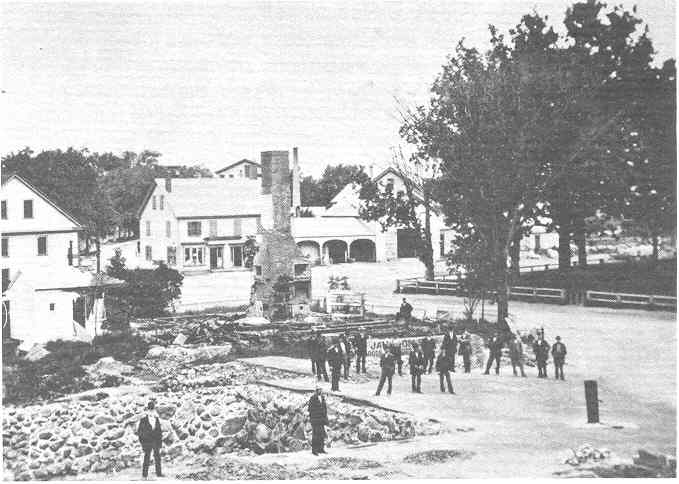
Second Public Library Site adjacent to the central building
as viewed across Atwood's Fire [in 1880]

Third Home of Library - now G.A.R. Hall
V. THE FIRST STOUGHTON PUBLIC LIBRARY BUILDING.
It is a well-known fact that the growth of public schools and public libraries go hand in hand. Early Town Reports of the School Committee deplore the state of public education repeatedly, imploring the town for funds to improve it. By the 1860's, a High School of sorts was instituted; in 1865 a room in the old Drake school was given over to the High School, with an enormous curriculum of mathematics, chemistry, philosophy, Latin, Greek, English literature, etc., for one teacher to administer. In 1873, the new Clapp School, which was later to burn down and be replaced by the present Clapp School, provided rooms with a staff of two (one of whom was Miss Amelia Clifton, graduate in Stoughton's first High School class in 1868), which alleviated the situation for a while. The need for High School education was being recognized.
In 1883, an important social and educational group, the High School Association, was formed by some of Stoughton's most prominent citizens. W. O. Faxon was its first President; Edwin A. Jones, Vice President; and William Atherton, Treasurer. This society held "first place in the social life of the town for better than 40 years. Its membership was highly regarded, sought after, and welcomed." The High School Curriculum was severely criticized in 1891 by Supt. Edward Fitts; the lack of interest in High School was deplored in 1894, by Principal Strong. A Committee consisting of Oscar Marden, Christopher Farrell, and E. A. J ones was appointed in 1896 to revise the course of study. By 1899, the Principal "rejoiced at record registrations, bring the number of pupils up to 137." With the success of the support of certain local citizens, the schools, particularly the High School, became overcrowded; the School Committee, in 1900, recommended a new High School to relieve the lower grades from a serious deterioration of scholarship because of crowding.
The population of Stoughton in 1902 was 5,442; there were 702 pupils in school, with a per capita cost of $21.91. The schools had reached "a crisis where discipline was a mockery because of overcrowding." A new school was built behind the Clapp School, to which the High School was removed, thus relieving some congestion. This new Kimball School was opened in 1903; by 1912, the High School had taken over the entire building.
Meanwhile, the Public Library was experiencing its own growing pains. Apparently, Mr. Jones was not successful in his correspondence with Mr. Carnegie, for in 1902 Lucius Clapp once more answered the call for private aid and donated $25,000 for a new Library Building. On October 28, 1902, the Trustees and the Library Site Committee met and voted to purchase the Atherton lot for $6,800. Wales French and E. A. Jones were a committee to purchase it and "secure funds for the building from the donor." In May, 1903, Mr. George Monk, who his daughter relates was chosen by Lucius Clapp to direct the building of the Library, was designated a committee by the Trustees to "dispose of the iron fence and sell the grass of the library lot." The contract and specs for the building were signed May 29, 1903; the architect chosen was Walter Atherton, who planned the building which would be erected on the field beside his boyhood home.
[Click here for a 1876 Map of Stoughton]
One of the first decisions reached was the contents of the cornerstone of the first Public Library Building; the Trustees voted to include sketches of the history of the Library, the Stoughton Musical Society, and the Historical Society among the material, and a picture of Wales French. The June 17, 1904 Dedication of the Stoughton Public Library culminated the long and dedicated efforts of a group of leading citizens to bring true library service to the community. Looking back to the lives of these men, we see them deeply involved in a common concern for its educational and civic institutions; they served as Selectmen, members of the School Committee, Trustees of the Library, and in a number of other organizations for the improvement of the Town.
Wales French, for many years one of Stoughton's prominent businessmen, was a founder, Trustee, and librarian for the Stoughton Public Library; he was President of the Stoughton Co-operative Bank; President of the Fortnightly Club; President of the Historical Society; and Secretary-Treasurer of the Evergreen Cemetery. The Stoughton Sentinel rightly said of him at his death in 1916: "Although the Stoughton Public Library will be known by other names than that of Wales French, it will stand permanently as a monument to his energy, devotion, and public spirit, for in its foundation he was the moving spirit, and it has been his life work . . . The history of the Stoughton Public Library is a part of the history of the life of Wales French. Founded in 1 874, he was the father of the movement which brought it about, and he has been its head and that without remuneration . . . The Library was founded through the efforts of members of the Stoughton Literary Association, which had a library from 1865—70, but which went out of existence at the later date. Mr. French was the moving spirit of that society." His business life was spent in the manufacture of boots and shoes, in company with his father, the late Daniel French; their factory was the building later occupied by J. W. Wood's. In 1906, the Trustees voted to hang his portrait in the Trustees' Room, as a constant tribute.
One of Stoughton's leading benefactors, Lucius Clapp, will long be remembered for his many gifts to the town. He was "reared a farmer; took pride in agriculture, and has always followed that avocation, and was one of the representative farmers of that progressive age." From his early gifts of books to the infant library through his years as a Trustee (and chairman of the Board), Lucius Clapp maintained his support of the public library even to bestowing his magnificent gift of the first Library Building at 6 Park St. (now fittingly named the Lucius Clapp Memorial Building). Mr. Clapp also served on the Board of Selectmen, on the School Committee, and on important committees of the town, "where his judgment was always valued"; he was connected
with every movement for the betterment and advancement of his native town, even the Temperance Movement. On his death at 92, the Sentinel is quoted: "He has been successful in business, and has used the funds Providence has given into his care wisely, and done much to make him remembered as a liberal and kind-hearted man." Before his death, the Trustees were to thank Mr. George Brewster, local sculptor, "for the gift of the handsome mural portrait of Lucius Clapp;" this bronze portrait hangs now, appropriately, in his brick building in the Square.
Henry L. Pierce, who in 1898 willed $25,000 to the Stoughton Public Library for the purchase of books, was another civic-minded benefactor. Born on Highland St. in Stoughton, the Hon. Henry L. Pierce rose to be Mayor of Boston and a Congressman in the 43rd and 44th Congress in Washington. Henry's brother Edward, was a prime mover for the Milton Library, and became Chairman of its Board of Trustees in 1871. Both distinguished men in their fields, they found time and funds to support their local libraries. A plaque commemorating Henry L. Pierce's generosity hangs in the entry to the new Stoughton Public Library at 84 Park Street.
Along with other early Trustees, Edwin A. Jones and George Monk should be remembered for their contributions to the town and the Public Library. Amelia Clifton, graduate in the first class of Stoughton High School, assistant in the first High School Building, was also the first woman to serve as a Library Trustee. She served long and capably on the early Boards of Trustees, as well as Librarian for several years.
It was these devoted people who were responsible for the accomplishment which prompted The Stoughton Sentinel, in 1911, to report that "Stoughton has a public library second to none in beauty of design and in quality of its service and wealth of books." This Clapp Building was to serve the community well until it was outgrown in the middle of the century.
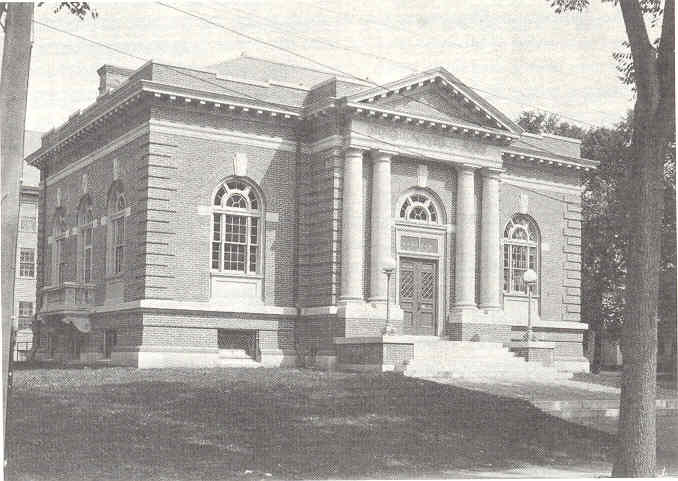
Stoughton Public Library Building Dedicated in 1904
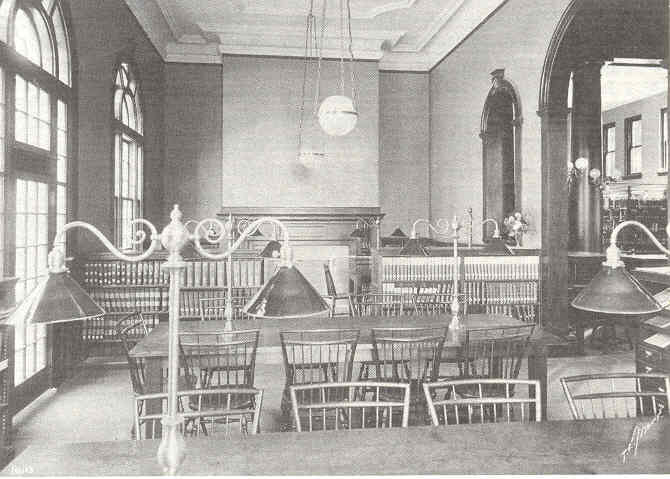
Interior of the Library now the Lucius Clapp Memorial Building
[home of the Stoughton Historical Society and Stoughton Musical Society]
VI. GROWTH OF STOUGHTON PUBLIC LIBRARY SERVICES
From the opening of the new Public Library building in 1 904, there was a steady growth in services to the public, personnel, budgets, and circulation; public-spirited citizens continued to contribute to its welfare. In 1913, M. Emeline Farrington left $1,000 to the Library for "pictures, statuary, or Interior Decoration not including ordinary painting", to help beautify the building. Miss Cassandana Phinney gave $500 to the Trustees to "promote the interests of the library", in 1916. Many interested women became workers in the building, carrying on Wales French's librarianship with the help of Trustees, who still chose books and periodicals. Despite the economies of the years of World War I and the budget cuts of the Depression in 1 932, the Library met its obligations to the public. By 1921, circulation figures rose to 41,496; in another 10 years, it had nearly doubled. It was not until the late 1 940's, however, that the Library was to hire its first professional librarian, Miss Solglad Burtch.
|
WE'VE COME A LONG WAY |
|
|
|
|
Comparative Budgets |
|
|
|
|
|
1874 |
1924 |
1973 |
|
Personal Services |
40.00 |
2,860.00 |
116,538.00 |
|
Books |
326.85 |
1,631.00 |
35,000.00 |
|
Expenses |
57.00 |
875.00 |
19,000.00 |
|
|
423.85 |
5,356.00 |
170,000.00 |
Fines: Still 2¢ per day for overdue books
The public library is no longer merely a collection of books and periodicals; Stoughton's has been, through the years, an innovative institution, offering up-to-date library service. Before 1907, when a new supply was purchased, other-than-printed materials were represented in a collection of Stereoscopic Views for the public. Today, the Library offers phonograph records, tape cassettes, jigsaw puzzles, games, framed art prints for home use, and even two healthy, happy gerbils for circulation among its patrons. Films may be borrowed through a film service from the Boston Public Library.
One of the Library's prime interests lies in providing foreign language books for various groups in town. As early as 1913, Wales French had purchased about 100 volumes for the Hebrew Library, to be loaned to the Hebrew congregation. In 191 5, the collection was augmented by the purchase of books in the Lithuanian language, in response to the needs of that small portion of the community.
An important part of the present collection is material at different levels of reading and interest in the Portuguese language. Light fiction, non-fiction, and periodicals in Portuguese have been purchased for this ever-growing segment of the town's population.
As the town became more involved with promoting the education of its children, the Library kept pace, beginning in 1900 by dropping the age limit to 12 years. In the 1920's, it investigated the possibilities of story hours for young children; a story-teller was employed in '24 to tell stories to first graders in the Clapp and Drake Schools at the Library: 68 pupils and their teachers attended the first session. Today, every second and fourth grade class is brought to the Library during the school year for an hour's orientation to introduce the children to available library material and to teach them how to find it. Twenty boxes of books are distributed to second grades at the beginning of the school year, with rotation in January, to supplement the schools' collections of recreational reading. The Children's Librarian (this position was made available in 1 957) and the school Reading Supervisor prepare summer reading lists for the first six grades. The Children's Librarians conduct an active reading club each summer, advise a Girls' Library Club and Junior Stamp Club, and offer special film, craft, live animal, and science programs in addition to book reviews. Pre-schoolers are offered a popular story-telling hour with four programs a week. Thus a variety of activities are maintained to stimulate a child's interest and appreciation of a public library.
The Young Adults have long been recognized as a definite group, with their own Young Adults Librarian and Youth Council. Not only are periodicals, rock and show records, supplementary curriculum texts, fiction and non-fiction of high interest, and reference works available to this group, but their own programs such as live rock dances, baby sitter clinics, speakers, and various films are presented. They instituted a Library Chess Club, which is currently open to all ages. Young Adults are encouraged to make use of the entire Library collection and not limit themselves to only young adult material.
One of the aims of the Public Library is to involve its patrons in activities using it as a community center; libraries nationally have developed into communication centers, rather than merely collections of books. Community interests were served back in 1 91 7 when the Library sponsored a Council to raise money to provide reading material for the soldiers at Ayer Camp; in 1925, a lecture series by the Norfolk County Agricultural School was popular. Today special bibliographies and programs concerning wide-ranging topics on drugs, ecology, remedial reading, handcrafts, and film programs are planned for adults. An active adult stamp club (Old Colony Philatelists) meets regularly at the Library. Art exhibits have been held periodically since 1909, when the Woman's Club was given permission to hold one. Local artists, from F. Mortimer Lamb and Charles Vermoskie to the present High School students have been encouraged to hang their works in the Library. Bringing the Community to the Library has been facilitated by the use of the meeting room in the present Library, which has been used by many local organizations like the Woman's Club, Rotary, League of Women Voters, B'nai B'rith, and the Fieldbrook Young Woman's Club. Record players, donated by the Woman's Club, are available to adults for use in the Library. A copy machine is widely used by the public; the local newspaper and New York Times are available on microfilm through the use of the microfilm reader/printer. Patrons may also borrow the Library's membership card to the Museum of Fine Arts, Boston, the Boston Museum of Science and Fuller Art Memorial, Brockton.
One of the first public libraries in this area to understand and support the concept of a regional library system, Stoughton Public Library is an active member of the Eastern Massachusetts Public Library Regional System. The Trustees, in May of 1 971, waived the non-resident borrower's fee and encouraged burgeoning patron use of interlibrary loans. By obtaining titles from libraries throughout the state (in addition to extensive use of the sub-regional headquarters at Thomas Crane Public Library in Quincy and the regional headquarters at Boston Public Library) Stoughton patrons can draw from an enormous collection of materials.
When Emeline Farrington left her legacy for purchasing art works for the Library, she stimulated the Trustees' interest in collecting worthy "Interior Decoration" with an eye to permanency. Serious deliberation was given to the selection of standard reproductions of "Sir Galahad", Rosa Bonheur's animals, and Raphael's "Madonna", including a debate on the value of Turner's "Ulysses Deriding Polyphemus", which was finally purchased for the children's room. In time, local photographer George A. Gerard and painter F. Mortimer Lamb were consulted to help choose works of lasting quality.
F. Mort Lamb gave freely of his time and advice, and eventually some of his well-known paintings found their way to the walls of the Public Library. Mr. Lamb became an internationally known painter in oils and pastels, dearly esteemed by his townspeople; today the Stoughton Public Library is fortunate in owning a sizeable collection of his works, which is on permanent display in the meeting room. Many of these paintings had suffered deterioration in years of storage; through the generosity of Miss Beatrice Monk, a cousin of Mort Lamb and daughter of Trustee George Monk, the Library's entire collection was repaired and restored for its present display.
During World War I the Trustees foresaw the value of a collection of War Posters from many countries. They zealously collected posters from Washington, the French, English, and Italian Embassies, and Canada, which were displayed in the Public Library and in public places as part of the Library's war efforts. These posters have also been restored by professional artisans who report they number among the finest World War I Poster Collections in New England. These, too, are a valuable asset to the Library's permanent collections.
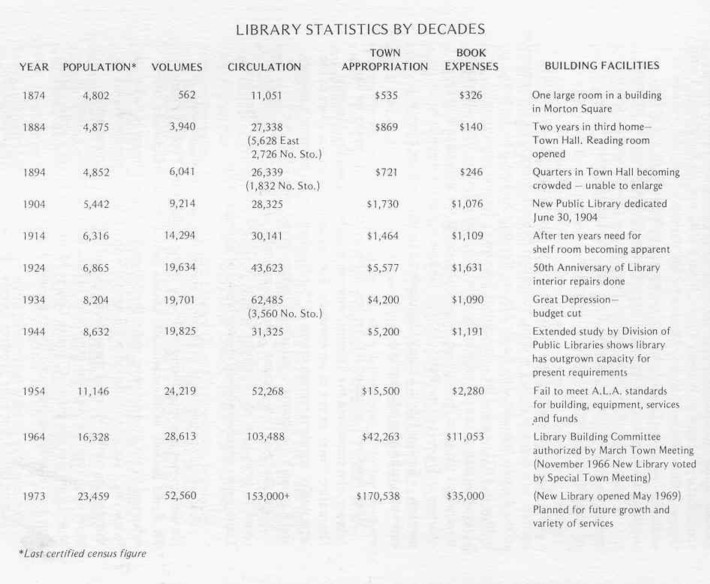
The Public Library has a special area which houses its Stoughton Collection. This represents books and other literary material, some pictures, references, and documents which are related to the history of the town. This collection is available to patrons for use within the Library.
As the services in public libraries developed to encompass the entire community, it became apparent that the once highly satisfactory building would no longer house all the facilities available. The problem of transportation instigated, in 1924, an early attempt to establish a branch library after school at the North Stoughton School, similar to the very early East Stoughton Branch Library. The infeasibility of maintaining several libraries was recognized, however, and the one building had to suffice for the growing population. In 1945, the Division of Library Extension conducted a survey which made obvious the shortcomings of the two reading rooms for all ages of Stoughton patrons. The Trustees requested the Division to revise its survey in '59, when it was determined which areas must be improved to fulfill State Minimum Standards. After an unsuccessful attempt to construct an addition to the Clapp Building, a new Study Committee was appointed to come up with a solution to the overcrowding and regression of services.
The Library Building Committee successfully served the town with its plans for a modern facility on a new site within walking distance of the old, which would take care of all foreseeable library functions for the next half-century. In fiscal 1967 the Town of Stoughton received the second highest Federal grant to a public library in Massachusetts under the Library Services and Construction Act, to assist the Town with the cost. The new Stoughton Public Library, opened on May 18, 1969, was designed by Richmond and Goldberg, Architects; it is a beautifully functional building with an open concept for flexibility and growth, areas for separate children's and adult functions, a meeting room for library and town organizations, ample work areas for the staff, and a generally pleasant and inviting atmosphere.
With a full staff to care for the needs of the library public, the Stoughton Public Library looks forward to increasing its function as a center of communication in Stoughton. State Aid funds have enabled the Trustees to introduce new services and material without burdening the Town Budget; it is hoped that some experimental service with audio-visual media and programs of widening interest to the public, as well as a continued research for historical and literary references will be part of the future total library experience.
Library Activities [circa 1974]
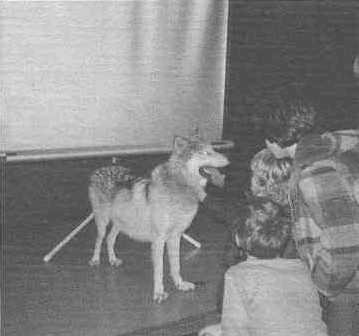 Rocky the
wolf and his admirers
Rocky the
wolf and his admirers
Live theatre in Faxon Park on a hot summer day 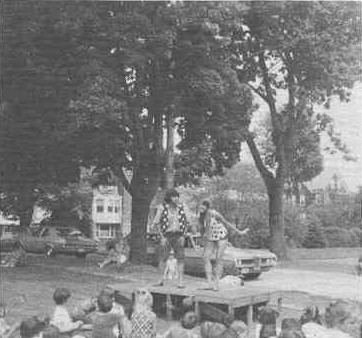
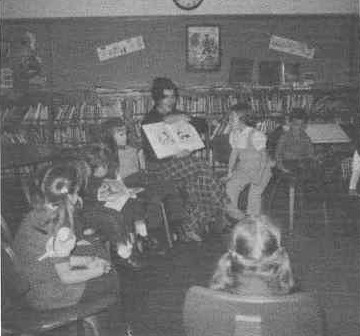 Peggy Sewcyk storytelling spellbound pre-schoolers
Peggy Sewcyk storytelling spellbound pre-schoolers
Cartooning at its best 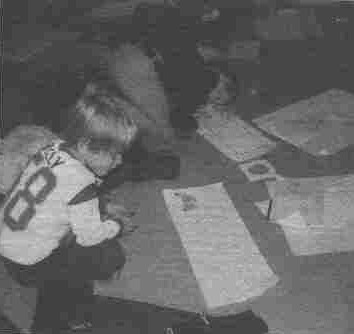
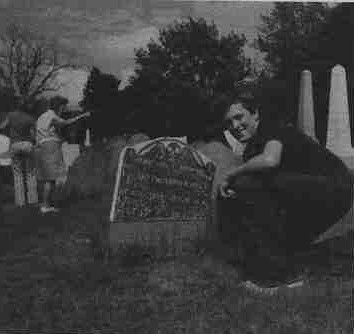 Gravestone
rubbings at Pearl Street Cemetery
Gravestone
rubbings at Pearl Street Cemetery
Performers of "The Little Blue Wagon, University
of New Hampshire 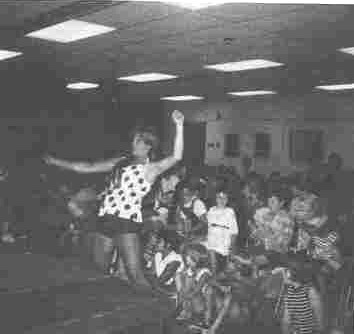
An alert and knowledgeable staff is a vital part of good library The Stoughton Public Library or Staff are members of the American Library Association, New England Library Association, Massachusetts Library Association, Massachusetts Library Trustees Association, Old Colony Library Club, and Greater Boston Public Library Administrators, where an interchange of ideas and problems aids in improving one's own system.
The Board of Trustees, finally, is charged with the responsibility of insuring good library service. In setting Library policy, the Board early recognized the value of the A. L. A. Bill of Rights, and enrolled Stoughton Public Library as a charter member of the Freedom to Read Foundation. Trustees must also prepare good working budgets for Town Meetings arid communicate Library needs to Town Boards and Town Meeting members. Their concern is to provide the best library materials and programs for the enjoyment, edification, and cultural enrichment of their patrons.
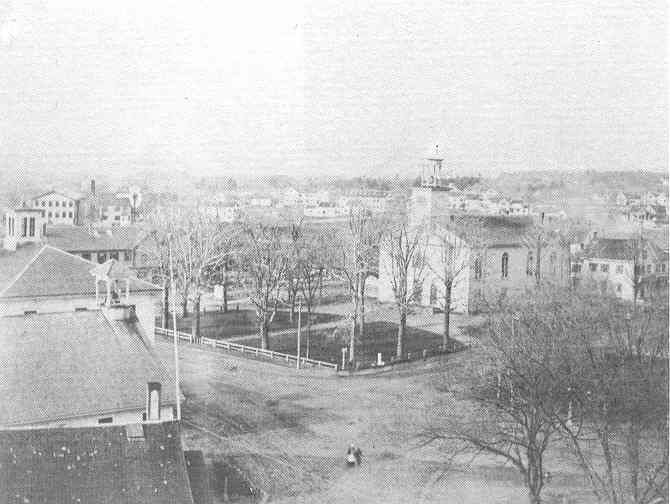
View of Square in 1885 showing site of Lucius Clapp Memorial Building
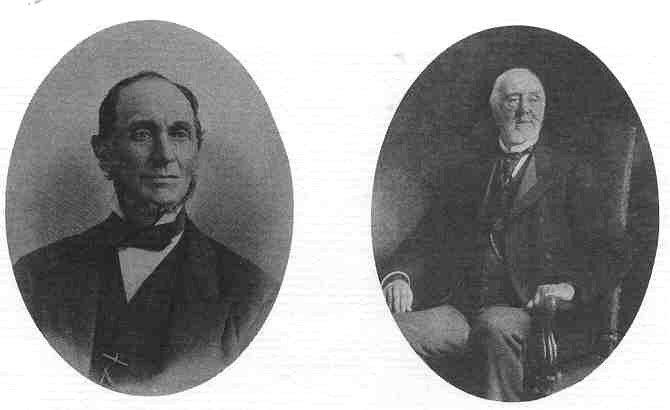
Lucius Clapp (Trustee and Donor, Library Building) Henry Lillie Pierce (Donor Book Fund)
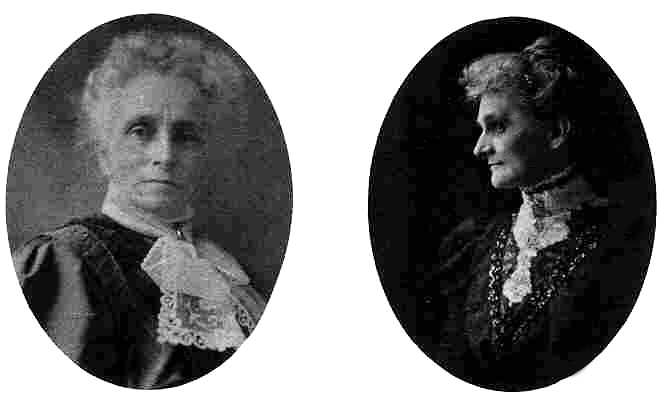
Amelia M. Clifton (Trustee and Librarian) L. Alice Talbot (Trustee)

Exterior present Library
84 Park Street

Interior of the present facility
Written and compiled by Dorothy M. Woodward
with the Editorial assistance of Daniel E. Hughes, Ed.D.
Statistical tables compiled by Barbara Canavan
Website Editor Note: Many thanks to the Trustees of the Stoughton Public LIbrary who granted permission for www.StoughtonHistory.com to make this publication available online.
Back to the main page of www.StoughtonHistory.com